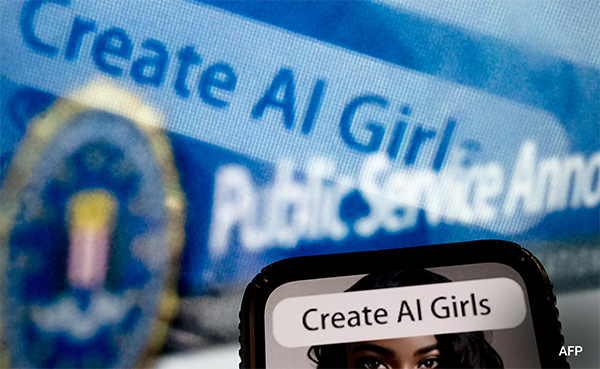Deepfakes danger: How can you protect yourself
Deepfakes danger: How can you protect yourself
Mangalore Today News Network/NDTV
New Delhi, Mar 25, 2024: Deepfake technology has emerged as a major concern in recent years, with people, especially celebrities increasingly becoming targets of this form of manipulation. Deepfakes are convincing but entirely fabricated media -- in the form of AI-generated videos or audio clips - that use people’s faces and voices.

Often made with a malicious motive, they pose significant risks to the reputation and privacy of the targeted people. These manipulated videos can be used to spread false information, defame people, or even blackmail them. With the advancement of deepfake technology, the line between reality and fabrication becomes increasingly blurred, making it challenging for both the public and authorities to separate the truth from fiction.
How to protect your data from deepfakes?
While there is no sure-shot way to ensure 100% protection, there are several steps you can take to minimise the risk of your media being accessed and exploited by deepfake tools.
1. Avoid sharing personal images or videos on social media or other public platforms whenever possible. If sharing is necessary, set your privacy settings to the highest level.
2. Strengthen the security of your online accounts by using strong and unique passwords. This makes it harder for hackers to gain unauthorised access to your images and videos, making it less likely to get targeted by deepfake tools.
3. Invest in a good antivirus program to protect your computer from malware that could potentially be used to create deepfakes. This way, you minimise the risk of malicious tools gaining access to your media.
4. Familiarise yourself with the common indicators of deepfake content. If a video or image seems too perfect or unrealistic, be cautious of sharing or believing it. Being aware of the signs can help you identify manipulated media.
5. Adding watermarks to your pictures and videos can act as a deterrent against unauthorised use. While not foolproof, watermarks make it somewhat difficult for others to claim your work as their own, providing an additional layer of protection.
6. Making sure that the metadata embedded in your files accurately says the ownership details, creation dates, and other relevant information. This can serve as evidence of ownership in case of disputes or conflicts over the use of your media.
- Mangaluru: Man loses Rs 22.6 lakh in online trading scam
- Bantwal: Vittal police raid illegal sand stockyard; machinery and sand seized
- Suhas Shetty Murder case: NIA raids 13 locations in Bajpe, Suratkal
- Dharmasthala: Excavation at 9th site yields no remains; search to continue at tenth site
- Chhattisgarh: Court grants bail to two Kerala nuns in human trafficking-conversion case
- Mangaluru: Two OBG and anaesthesia specialists to be posted in every taluk hospital, says Dinesh Gundu Rao
- Bantwal: Pillion rider dies after two-bike collision at Punjalkatte
- Puttur: Theft accused re-arrested after six years of absconding, fresh case filed
- Puttur: Pedestrian dies after being hit by auto-rickshaw at Pape Majalu
- Mangaluru: Ammonia leak at Baikampady fish processing unit; four workers Critical, 25 hospitalized
- Police arrest three, seize 123 kg cannabis near Moodbidri
- Prices of commercial LPG gas cylinders reduced by Rs 33.50
- St Antony Church, Kulur holds paddy transplantation drive to promote ecology and tradition
- Want to live again? German firm offers to freeze your body for Rs 2 crore and revive you later
- Futuristic changing room in Goa store leaves UK couple amazed: "Third world who?"
- Chemistry professor who used science to explain husband’s death gets life term for murder
- Name: Dog Babu, father’s name: Kutta Babu. Pooch issued residence certificate in Bihar!
- Kerala bus driver eats jackfruit before breathalyser test, here’s what happens next
- Video: Horses fight in Madhya Pradesh, one leaps into rickshaw and gets stuck
- Chilling moment roof of double decker bus ripped off by bridge, passengers left screaming
- Content creator highlights ugly side of travelling with Indian passport, sparks discussion
- 8-year-old wheelchair user walks again after receiving experimental drug for rare genetic condition
- Australian woman, 20, gives birth 17 hours after discovering she was pregnant: "Crazy experience"
- Bengaluru residents honour stray dog with touching mural, internet in tears
- Video: UP woman flaunts gun while dancing on highway for Insta reel, police reacts
- Prajakta Koli becomes the only Indian on 2025 TIME100 creators list
- Ex-MP Prajwal Revanna sentenced to life imprisonment in rape case
- Tejashwi Yadav alleges name missing from Bihar electoral draft list; EC says claim mischievous
- Stay home to avoid rape: Gujarat traffic police’s safety drive posters draw ire
- Bangladeshi model arrested in Kolkata, fake Aadhaar, Ration Cards recovered
- Delhi court issues notice to Robert Vadra in money laundering case
- ’Lok Sabha poll was rigged’: Rahul Gandhi claims India’s election system is dead
- 37-year-old man faints after workout session in Pune gym, dies
- Auto fares go higher in Bengaluru, drivers refuse to calibrate meters
- Terrorist killed in encounter in J&K, Army says "Operation Akhal" underway
- Salary Rs 15,000, assets worth Rs 30 crore: Karnataka’s ex-Clerk owns 24 houses, 40-acre farm land
- Former MP Prajwal Revanna convicted in rape case
- After Jagdeep Dhankhar’s exit, Vice Presidential poll to be held on September 9
- CITY INFORMATION
- TRAVEL
- TOURIST INFORMATION
- HEALTH CARE
- MISCELLANEOUS




 Write Comment
Write Comment E-Mail
E-Mail Facebook
Facebook Twitter
Twitter  Print
Print 




